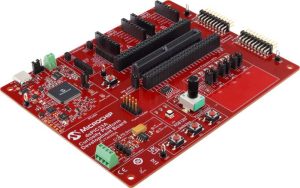
dsPIC33A, as the family will be called, is aimed at fast closed-loop control of PSUs and motors.
As with earlier dsPIC processors, the parts remain a combination of CPU and maths accelerator (‘DSP engine’), rather than a pure DSP architecture.
In this fifth generation, the DSP engine has acquired two 72bit accumulators, 32bit working registers, and seven context switching registers to reduce latency in real-time applications.
..33A parts also get a double-precision floating-point unit, which is IEEE 754-2019 compliant and also supports single precision. Its “dedicated pipeline improves software reliability and control loop speed”, Microchip told Electronics Weekly, “and [it] includes hardware-based sine and cosine functions.”
Some of the notable peripherals are: 40Msample/s 12bit ADCs, 5ns comparators, 100MHz operational amplifiers, 2.5ns PWMs and a BiSS (bi-directional synchronous serial) industrial interface.
“dsPIC33A DSCs are enhanced with improved math and data processing, higher code efficiency, faster context switching and reduced latency for a faster response time to transient and safety-critical events,” according to the company. “Upgraded peripherals are designed to support technology development in markets including automotive, industrial, consumer, e-mobility, data center and sustainable solutions.”
In automotive markets, the company is aiming at AEC-Q100 Grade 0 qualification with a -40 to +150°C operating range.
Many of the peripherals can be set-up to interact without further CPU involvement – ‘core independent peripherals’ in Microchip’s branding.
Specific security and functional safety features have been built-in, for example: secure boot, an immutable root-of-trust, secure debug, flash segment access restriction, peripheral access control and clock monitoring.
First out of the block will be the dsPIC33AK128MC1xx series with 128kbyte of flash, in SSOP, VQFN and TQFP packaging from 28 to 64 pins – the smallest measures 4 x 4mm.
“Future dsPIC33A families with additional memory, peripherals and larger pin counts will complete the portfolio,” said Microchip.
As earlier sdsPICs were 16bit, will legacy code run on these 32bit devices?
“dsPIC33A DSCs offer common peripherals and look and feel to the older dsPIC33 generations,” the company told Electronics Weekly. “Legacy assembly code can run directly on the new core. For legacy C-code, retargeted for the dsPIC33A, the compiler will identify any registers that need to be updated. To take advantage of the 32bit CPU, many customers will want to adapt their code for some of the newer instructions and capabilities.”
A migration guide from ..33C to ..33A processors is due out in August.
Development is supported by the company’s XC-DSC compiler and a graphical ‘code configurator’ to create initial C-code.
 Development board EV74H48A (left) will accept mikroBUS and Xplained Pro interfaces “that enable connection to ‘Built-in Self Text Xplained Pro’ extension kits, sensors and various Click boards”, said Microchip. “Separate modules are available to support development for motor control, digital power conversion and general-purpose embedded applications.”
Development board EV74H48A (left) will accept mikroBUS and Xplained Pro interfaces “that enable connection to ‘Built-in Self Text Xplained Pro’ extension kits, sensors and various Click boards”, said Microchip. “Separate modules are available to support development for motor control, digital power conversion and general-purpose embedded applications.”
 What it doesn’t mention there is that the board has no dsPIC33A, just a slot for one, which comes on a separately-bought daughter card (right).
What it doesn’t mention there is that the board has no dsPIC33A, just a slot for one, which comes on a separately-bought daughter card (right).
This has been Bus Widening month for Microchip – earlier it announced its first 64bit MCUs, using RISC-V cores from SiFive.
 Electronics Weekly Electronics Design & Components Tech News
Electronics Weekly Electronics Design & Components Tech News



